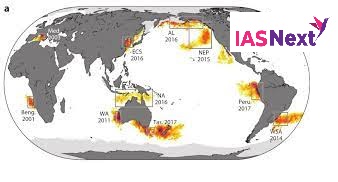CURRENT AFFAIRS
Get the most updated and recent current affair content on Padhaikaro.com
What are ‘marine heatwaves’?
- IAS NEXT, Lucknow
- 10, Feb 2022

A marine heat wave is usually defined as a coherent area of extreme warm sea surface temperature that persists for days to months. Marine heatwaves happen when sea temperatures are warmer than normal for an extended period. MHWs have been observed in all major ocean basins over the recent decade.
Causes:
- The most common cause of marine heat waves are ocean currents which can build up areas of warm water and air-sea heat flux, or warming through the ocean surface from the atmosphere.
- Weak winds: Normally, sunlight passes through the atmosphere and heats the surface of the ocean. If there are weak winds this warm water doesn’t mix with the cooler waters below. It sits on top and continues to heat leading to marine heat waves.
Impacts of rising marine heatwaves:
- Affect ecosystem structure, by supporting certain species and suppressing others.
- Can change the habitat ranges of certain species, such as the spiny sea urchin off southeastern Australia which has been expanding southward into Tasmania at the expense of kelp forests which it feeds upon.
- Can cause economic losses through impacts on fisheries and aquaculture.
- There is a link between marine heat waves and harmful algal blooms.
Marine heatwaves in Indian ocean:
According to a study, the Western Indian Ocean region experienced the largest increase in marine heatwaves at a rate of about 1.5 events per decade, followed by the north Bay of Bengal at a rate of 0.5 events per decade.
From 1982 to 2018, the Western Indian Ocean had a total of 66 events, while the Bay of Bengal had 94 events.
Factors affecting:
- The marine heatwaves in the Western Indian Ocean and the Bay of Bengal increased drying conditions over the central Indian subcontinent.
- Correspondingly, there is a significant increase in the rainfall over south peninsular India in response to the heatwaves in the north Bay of Bengal.